Can You Eat Leftover Poke
Yes, you can eat leftover poke, but you'll need to follow strict storage guidelines for safety. Store your leftover poke in an airtight container at or below 40°F immediately after serving, and consume raw poke within 1-2 days or cooked poke within 3-4 days. Watch for signs of spoilage like sour smells, discoloration, or slimy texture before eating. Don't leave poke at room temperature for more than 2 hours (1 hour if it's above 90°F), and always store it properly sealed in the refrigerator. From creative reheating methods to tasty transformation ideas, there's much more to discover about maximizing your leftover poke experience.
This post may contain affiliate links. If you make a purchase through these links, I may earn a commission at no additional cost to you. Additionally, portions of this post may be generated using artificial intelligence (AI) technology. While we strive for accuracy, please be aware that AI-generated content may not always be perfect and should be fact-checked when necessary.
The Spatula Scoops
- Yes, you can eat leftover poke, but raw poke should be consumed within 1-2 days when stored properly in the refrigerator.
- Store leftover poke in an airtight container at or below 40°F immediately after serving to maintain food safety.
- Check for signs of spoilage like sour smell, slimy texture, or discoloration before consuming stored poke.
- Cooked poke lasts longer than raw, with a safe consumption window of 3-4 days when refrigerated properly.
- Don't consume poke left at room temperature for more than 2 hours, or 1 hour in temperatures above 90°F.
Understanding Poke Safety Basics
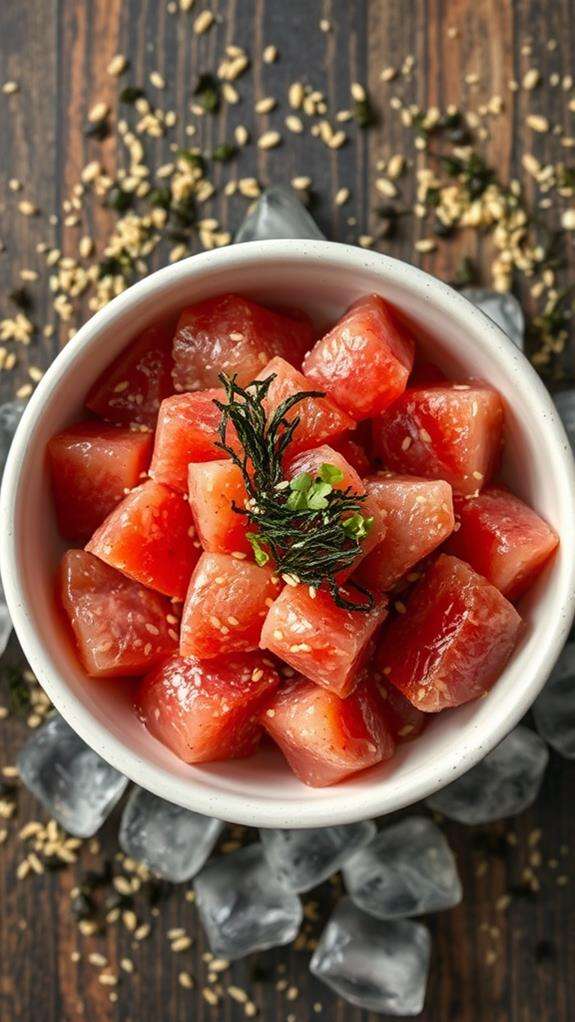
The safety of leftover poke requires careful attention to storage and timing. When you're dealing with raw fish, it's vital to understand proper handling to prevent foodborne illness and maintain the dish's quality.
You'll need to store your leftover poke in an airtight container and place it in your refrigerator's coldest section, maintaining a temperature at or below 40°F. This temperature control is essential because it helps slow bacterial growth that can lead to spoilage. You should consume your leftover poke within 1-2 days of refrigeration, though if you've opted for cooked poke, you can extend this window to 3-4 days.
Before eating your stored poke, you'll want to check for signs of spoilage. If you notice a sour smell, discoloration, or a slimy texture, don't take any chances – dispose of the food immediately. These warning signs indicate that bacteria have begun breaking down the fish, making it unsafe to consume. Remember that raw fish is particularly susceptible to bacterial growth, so you'll need to be extra vigilant with your leftover poke compared to other prepared foods.
Proper Storage Time Limits
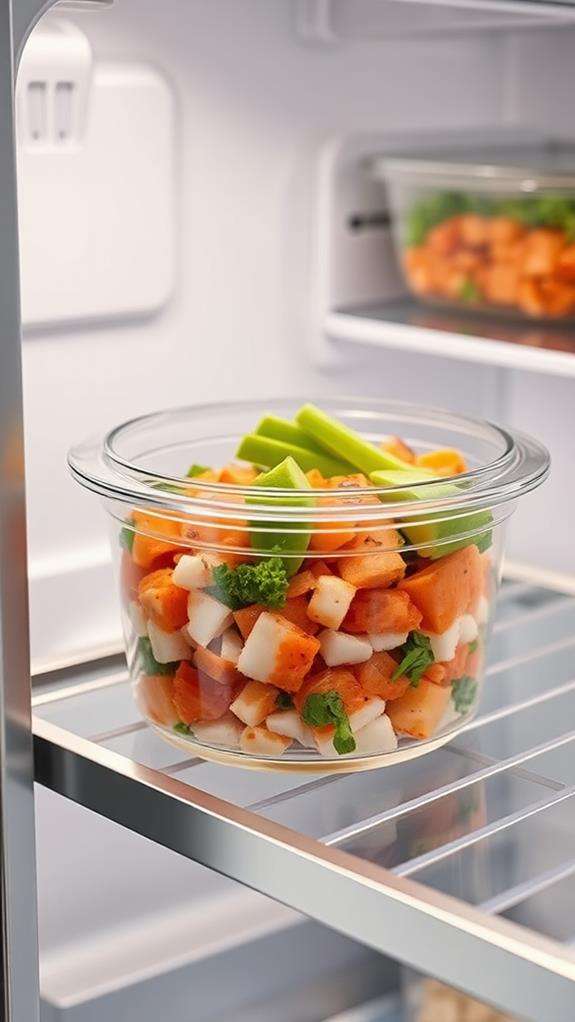
When you're storing leftover poke at home, you'll need to follow specific time limits based on the type you have, with raw poke being safe for 1-2 days and cooked variations lasting up to 4 days in your refrigerator. To maintain freshness and safety, you must keep your poke consistently refrigerated at or below 40°F (4°C), and it's essential to store it promptly after serving. If you've purchased your poke from a store, you can typically count on a 3-day window for safe consumption, though you'll get the best quality by eating it as soon as possible.
Safe Storage Time Frames
Proper storage time limits for leftover poke vary depending on whether it's store-bought or homemade. If you've purchased your poke from a reputable store, you'll have up to 3 days to consume it when stored properly in your refrigerator. However, if you've made the poke yourself at home, you should plan to eat it within 1-2 days to guarantee ideal freshness and safety.
When it comes to cooked poke, you'll have a bit more flexibility with safe storage time frames. You can safely store cooked versions for 3-4 days in the refrigerator, but it's essential to maintain a consistent temperature at or below 40°F (4°C). Throughout the storage period, you'll want to regularly check for any signs of spoilage before consuming your leftover poke. Watch for changes in texture, unusual odors, or any discoloration that might indicate the food has gone bad. If you notice any of these warning signs, it's best to err on the side of caution and discard the poke rather than risk consuming spoiled fish.
Temperature Control Matters
Maintaining precise temperature control is essential for preserving leftover poke's safety and quality. You'll need to store your leftover poke in an airtight container at or below 40°F (4°C) to prevent bacterial growth and maintain its freshness. If you're dealing with raw poke, you've got a narrow window of 1-2 days to consume it safely, while cooked poke offers more flexibility with a 3-4 day shelf life.
Temperature monitoring doesn't stop at refrigeration. When you're handling your poke, remember that room temperature exposure can quickly compromise its safety. You'll want to limit room temperature exposure to no more than 2 hours, or just 1 hour if it's particularly warm (above 90°F). If you've left your poke out longer than these timeframes, it's best to discard it rather than risk food poisoning.
Keep in mind that proper storage begins immediately after purchase or preparation. Even with careful temperature control, always check for signs of spoilage before eating leftover poke. If you notice any off-putting odors, unusual colors, or slimy texture, it's safer to throw it out.
Extending Poke Bowl Life
Understanding storage time limits can make the difference between enjoying fresh leftover poke and risking foodborne illness. To extend the shelf life of your poke bowl, you'll need to store your poke properly in airtight containers and maintain consistent refrigeration below 40°F.
When storing leftover poke, keep these essential timeframes in mind:
- Raw poke should be consumed within 1-2 days of refrigeration
- Cooked poke variations can last in the refrigerator for four days
- Properly stored poke in airtight containers maintains peak freshness
- Frozen poke remains safe for up to 3 months, but consume promptly after thawing
You'll want to check for signs of spoilage before eating any stored poke. If you notice color changes, unpleasant odors, or a slimy texture, it's best to discard the leftovers. When you're not planning to eat your poke within the recommended timeframe, you can freeze it to preserve its safety. However, remember that while freezing extends storage time, the texture may change slightly. Always thaw frozen poke in the refrigerator and eat it within 24 hours of defrosting.
Signs of Spoiled Poke
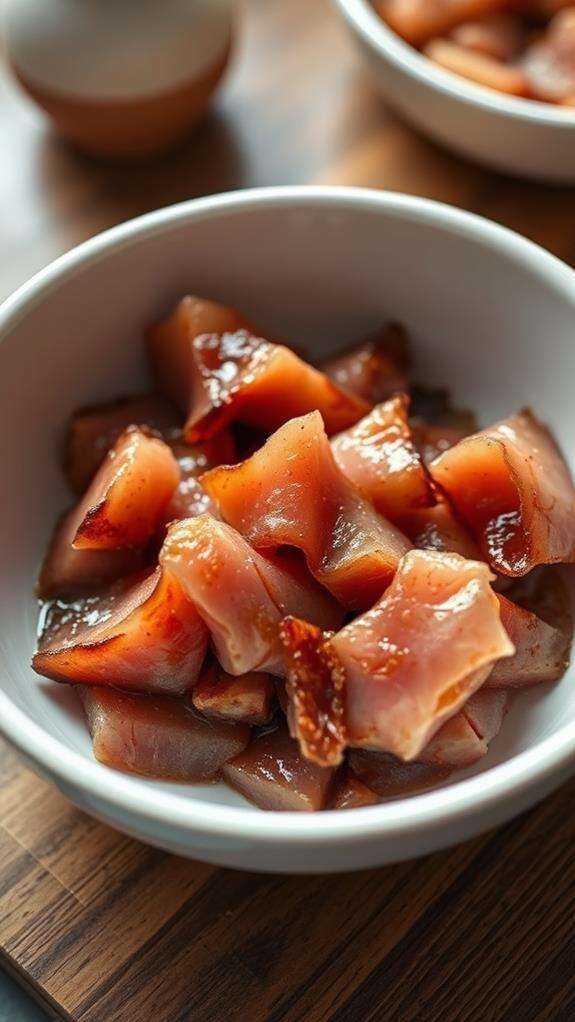
You'll need to use your senses to check if your leftover poke has gone bad, starting with a visual inspection for dull colors, dark spots, or any signs of mold. When examining the texture, be wary if the fish feels slimy or has developed an unusual, mushy consistency that differs from its original firm state. The most reliable indicator is often the smell—while fresh poke should have a mild ocean scent, any strong fishy odors, sour notes, or ammonia-like smells are clear signals that you should discard the poke immediately.
Visual and Smell Tests
Before taking a bite of day-old poke, it's essential to check for telltale signs of spoilage. You'll want to conduct both visual and smell tests to verify your leftover poke is safe to eat. When inspecting your poke, look for any changes in color, particularly dull or darkened spots that weren't present when the dish was fresh. A thorough inspection can help you avoid potential health risks and food poisoning.
Your sensory evaluation should include these important checks:
- Examine the fish's texture – if it feels slimy or has an unusual oozing substance, don't consume it
- Check for any strong fishy odor, sour smell, or ammonia-like scents, which indicate spoilage
- Look for mold growth anywhere on the dish, including the garnishes and sides
- Observe the overall appearance, watching for discoloration or mushy areas
If you notice any off-smells or visual signs of spoilage, err on the side of caution and dispose of the poke immediately. Don't try to salvage portions that appear safe, as bacterial growth may have spread throughout the dish even if it's not visible to the naked eye.
Texture Warning Signs
The texture of your leftover poke serves as a crucial indicator of its safety for consumption. When you're examining your poke, you'll want to pay close attention to several texture warning signs that could indicate spoilage. Fresh poke should maintain a firm and resilient texture that springs back when you touch it.
If you notice your poke has developed a slimy texture or is producing a thick, milky substance, you're dealing with bacterial growth and should discard it immediately. Watch for any oozing substance, which is a clear indication that the fish has begun to break down. You'll also want to be wary if your poke feels excessively soft or sticky when you touch it, as these characteristics suggest decomposition has begun. While you're checking the texture, don't forget to look for visual changes like dullness or dark spots on the fish's surface, as these often accompany textural deterioration. If you detect any mushiness or loss of the fish's natural firmness, it's time to err on the side of caution and throw it away rather than risk foodborne illness.
Safe Reheating Methods
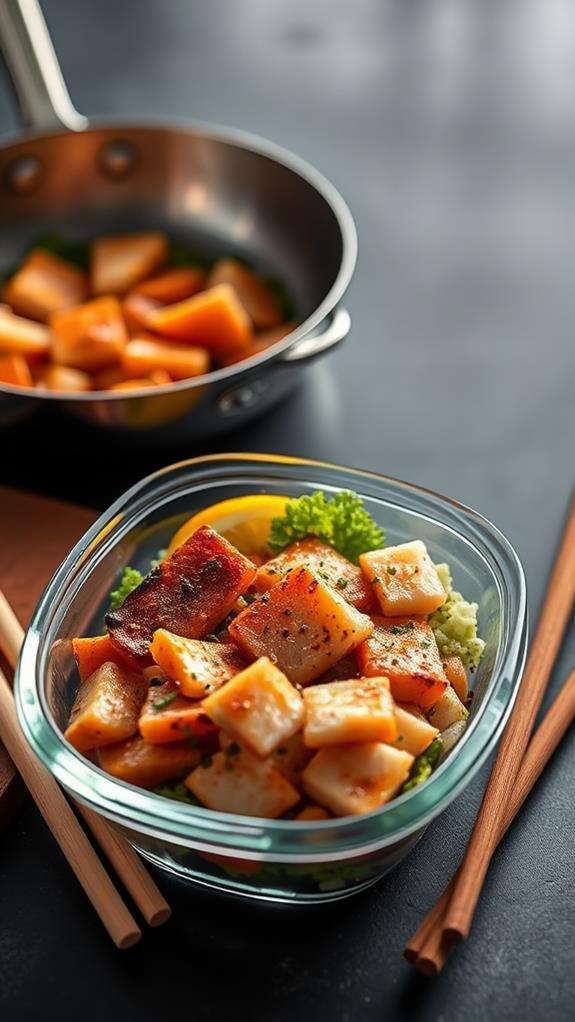
While reheating leftover poke requires careful attention, several safe methods can preserve its taste and texture. You'll want to make certain you're following proper techniques to maintain both freshness and safety while avoiding foodborne illness. When using a microwave, select medium settings and heat in 30-second intervals, stirring between each cycle to distribute heat evenly.
Here are the essential steps for safe reheating methods:
- Use a microwave-safe container and heat on medium power, checking frequently to avoid overcooking
- Heat in a non-stick pan over low to medium heat with a small amount of oil for even warming
- Monitor the internal temperature until it reaches 145°F for food safety
- Portion it out before reheating to avoid multiple reheating cycles
Remember to consume reheated poke immediately after warming it up. Don't store it again after reheating, as this can compromise both safety and quality. If you're planning multiple meals, it's better to portion out your leftover poke into individual servings before storing. This approach helps maintain freshness and makes certain you're only reheating what you'll eat in one sitting.
Creative Leftover Poke Ideas
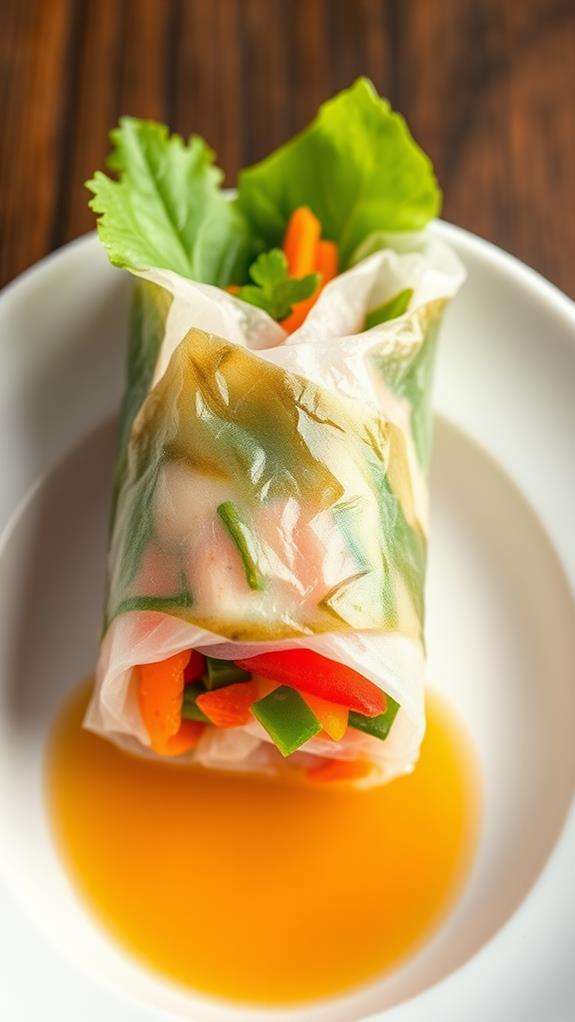
Transforming leftover poke into exciting new dishes opens up a world of culinary possibilities. You'll find that your leftover poke can become the star ingredient in various creative meals that'll make you forget you're eating leftovers.
One popular option is turning your leftover poke into a sushi roll by wrapping it with rice and seaweed, adding fresh vegetables for extra crunch and nutrition. If you're looking for a lighter meal, try mixing the poke with quinoa salad, enhanced with a simple sesame or soy dressing. For a Mexican-inspired twist, create fish tacos by adding your poke to tortillas, topped with avocado, cilantro, and spicy mayo.
You can also build a revitalizing poke bowl by combining the leftover fish with mixed greens and crunchy seaweed chips. For a more indulgent option, transform your poke into a creative snack by making nachos – simply layer tortilla chips with the poke, cheese, jalapeños, and a dollop of sour cream. These innovative preparations don't just prevent food waste; they create entirely new dining experiences from your original poke purchase.
Extending Poke Shelf Life
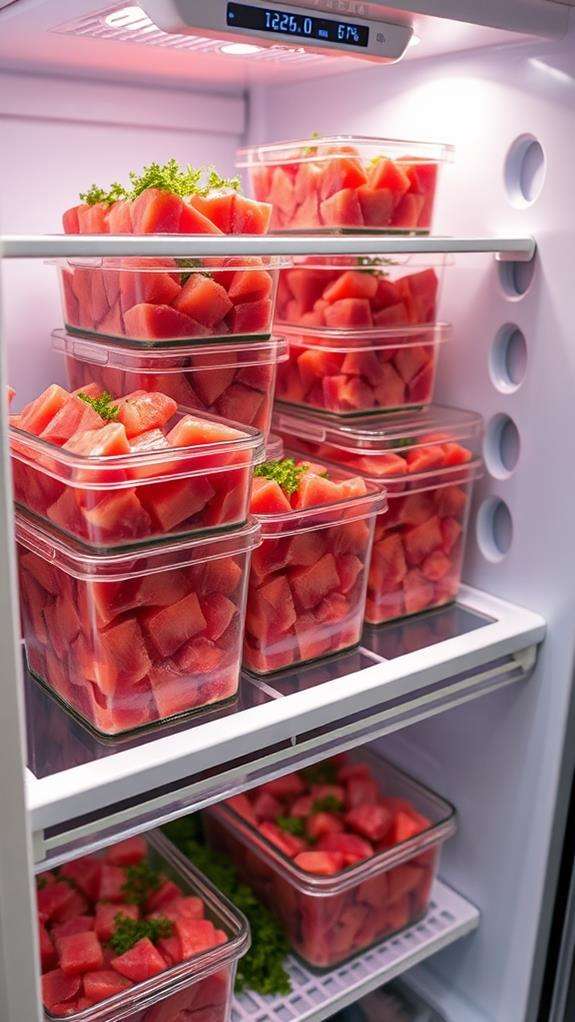
After exploring creative ways to use your leftover poke, you'll want to make certain it stays fresh as long as possible. To store poke properly, you'll need to place it in airtight containers and keep it in the refrigerator for 1-2 days. If you're planning to extend shelf life further, consider cooking the raw fish first, which will give you 3-4 days of refrigerated storage.
For long-term storage, you can preserve your leftover poke in a freezer-safe bag for up to 3 months. When you're ready to use it, remember to thaw frozen poke in the refrigerator rather than at room temperature. It's essential to inspect stored poke regularly for any signs of spoilage.
- Always check for unusual discoloration before consuming
- Watch for any slimy texture developing on the surface
- Monitor for strong, unpleasant odors
- Make certain the container remains properly sealed throughout storage
Best Storage Practices
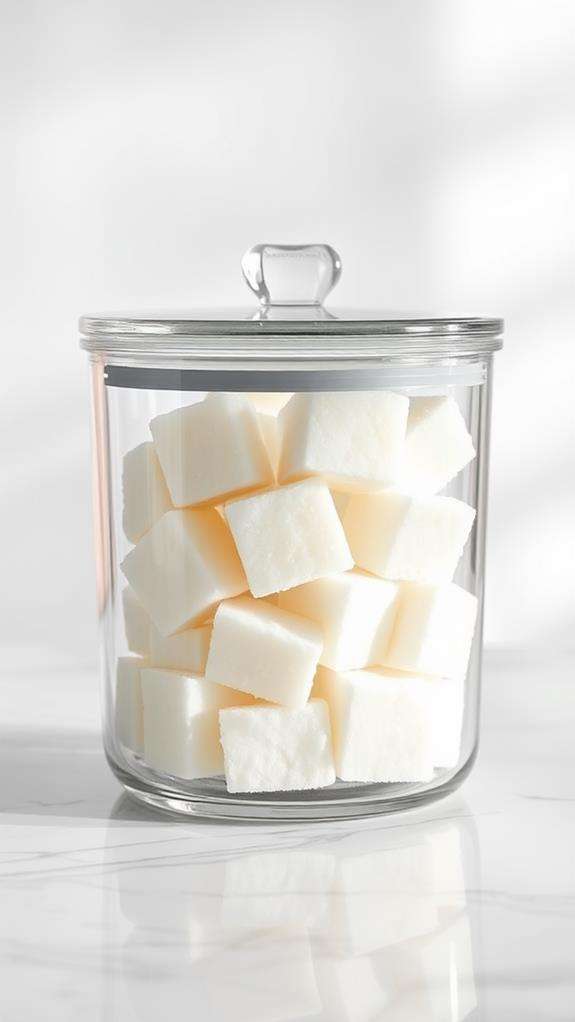
Proper storage techniques make all the difference in maintaining your leftover poke's quality and safety. When you're ready to store leftovers, place your poke in airtight containers to prevent oxidation and keep it fresh. You'll want to refrigerate it immediately at or below 40°F (4°C), and make sure to consume within 1-2 days for the best quality and food safety.
Label and date your containers clearly – this simple step will help you track how long your leftover poke has been stored. When arranging items in your refrigerator, keep your poke away from raw meats to avoid cross-contamination. If you're storing multiple containers, place them on upper shelves where there's less risk of drips from other foods.
If you can't eat your leftover poke within two days, freezing poke is a viable option. Transfer it to freezer-safe bags or containers, removing as much air as possible before sealing. While frozen poke can last up to three months, you'll notice the best quality when consumed within the first month. Remember that the texture may change slightly after thawing.
Food Safety Temperature Guidelines
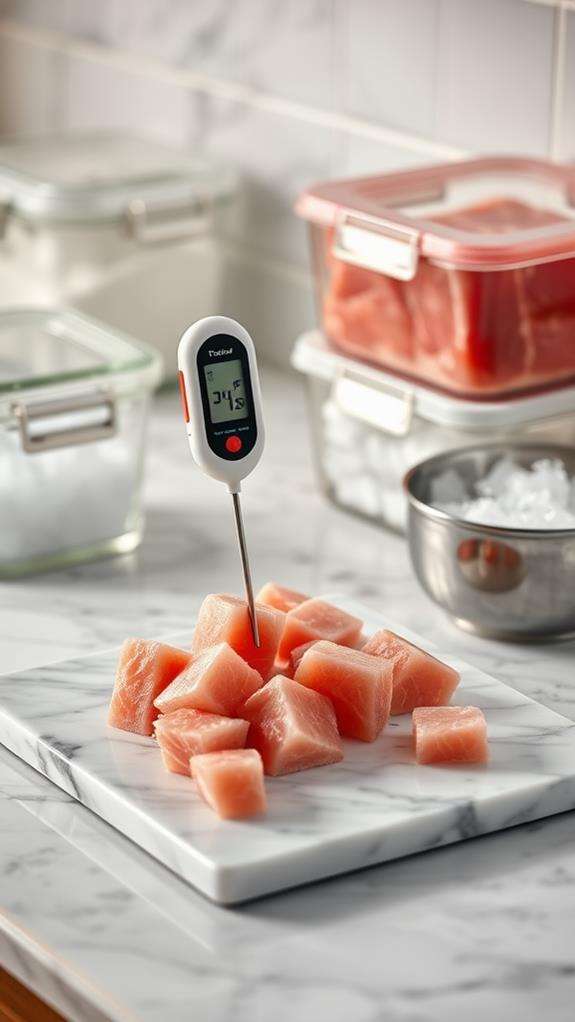
Food Safety Temperature Guidelines
Temperature control plays an essential role in keeping your leftover poke safe to eat. To prevent foodborne illness, you'll need to maintain proper temperature levels during both storage and consumption. Your refrigerator should be set between 32°F to 38°F (0°C to 3°C), as this range helps minimize bacterial growth and maintains the poke's freshness. Cold poke, much like leftover chicken, remains safe if stored correctly and consumed within a few days to avoid any risks associated with cold chicken safety guidelines.
When handling leftover poke, follow these critical temperature guidelines:
- Store your poke immediately in airtight containers and place them in the refrigerator within 2 hours of preparation (1 hour if it's hot outside)
- Keep your refrigerator temperature at or below 40°F (4°C) to maintain food safety
- If reheating, verify the poke reaches an internal temperature of 165°F (74°C)
- Monitor the time between removing poke from refrigeration and consumption
Before consuming your stored poke, always check for signs of spoilage, such as unusual odors, discoloration, or slimy texture. While proper temperature control considerably reduces the risk of bacterial growth, you should still consume your leftover poke within 1-2 days of preparation. Remember that maintaining consistent temperature control throughout storage is your best defense against potential food safety issues.
Leftover Poke Bowl Transformations
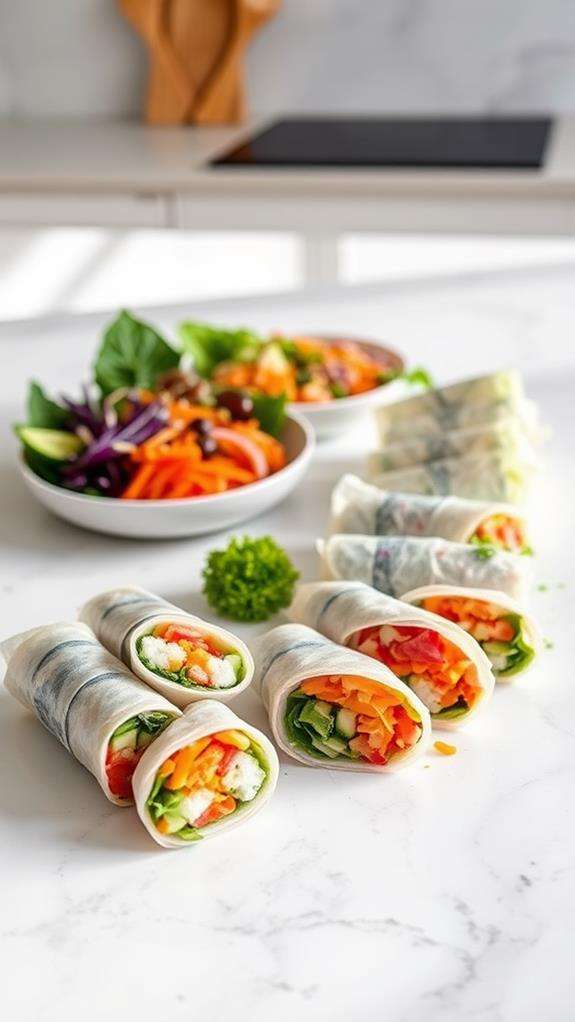
Leftover poke bowls can be reinvented into exciting new dishes that maximize both flavor and creativity. You'll find numerous ways to transform your leftover poke into fresh, appetizing meals that maintain the dish's nutritional value while offering unique twists on the original.
| Transformation | Ingredients Needed | Preparation Time |
|---|---|---|
| Invigorating Salad | Mixed greens, vegetables | 5-10 minutes |
| Sushi Rolls | Seaweed, rice, wasabi | 15-20 minutes |
| Poke Tacos | Tortillas, toppings | 10-15 minutes |
One simple transformation involves creating an invigorating salad by combining your leftover poke with crisp greens and fresh vegetables. If you're feeling creative, try incorporating your poke into homemade sushi rolls using seaweed sheets and rice. For a fusion experience, you can craft poke tacos by filling fresh tortillas with your leftover fish and complementary toppings. When you're short on time, consider reheating your poke and serving it over a warm rice bowl with additional sauces. You can even transform your leftovers into a crowd-pleasing appetizer by using them as gourmet nacho toppings, paired with cheese and guacamole.
Frequently Asked Questions
How Long Is Leftover Poke Good For?
Like a ticking time bomb, your leftover poke has a limited lifespan. You'll want to consume raw poke within 1-2 days when stored properly in your refrigerator at 32°F to 38°F. If you've got cooked poke, you've got a bit more wiggle room – it'll stay fresh for 3-4 days. Store-bought poke typically lasts around 3 days. Always keep it in an airtight container and watch for signs of spoilage like odd smells or slimy texture.
Are Poke Bowls Ok to Eat the Next Day?
Yes, you can safely eat your poke bowl the next day if you've stored it properly in the refrigerator at or below 40°F. When storing your leftovers, make sure to use an airtight container to prevent bacterial growth. While raw poke is best consumed within 1-2 days, bowls with cooked ingredients can last 3-4 days. Before eating, check for any signs of spoilage like odd smells, discoloration, or slimy textures.
Can I Eat Poke the Next Day Reddit?
According to food safety experts, nearly 85% of poke's freshness depends on proper storage. You can eat your leftover poke the next day if you've stored it correctly in an airtight container in the coldest part of your fridge (below 40°F). For best results, you'll want to consume it within 24 hours of purchase. Always check for any off-putting smells or discoloration before eating, and don't consume if you notice any signs of spoilage.
Can You Eat a Poke Bowl Cold?
Yes, you can definitely eat a poke bowl cold – in fact, that's how it's traditionally served! The raw fish and other ingredients are meant to be enjoyed at a chilled temperature. When you're eating your poke bowl, you'll want to make sure it's been stored properly in the fridge at or below 40°F. The cold temperature helps maintain the fresh flavors and textures of the fish, veggies, and other toppings.





